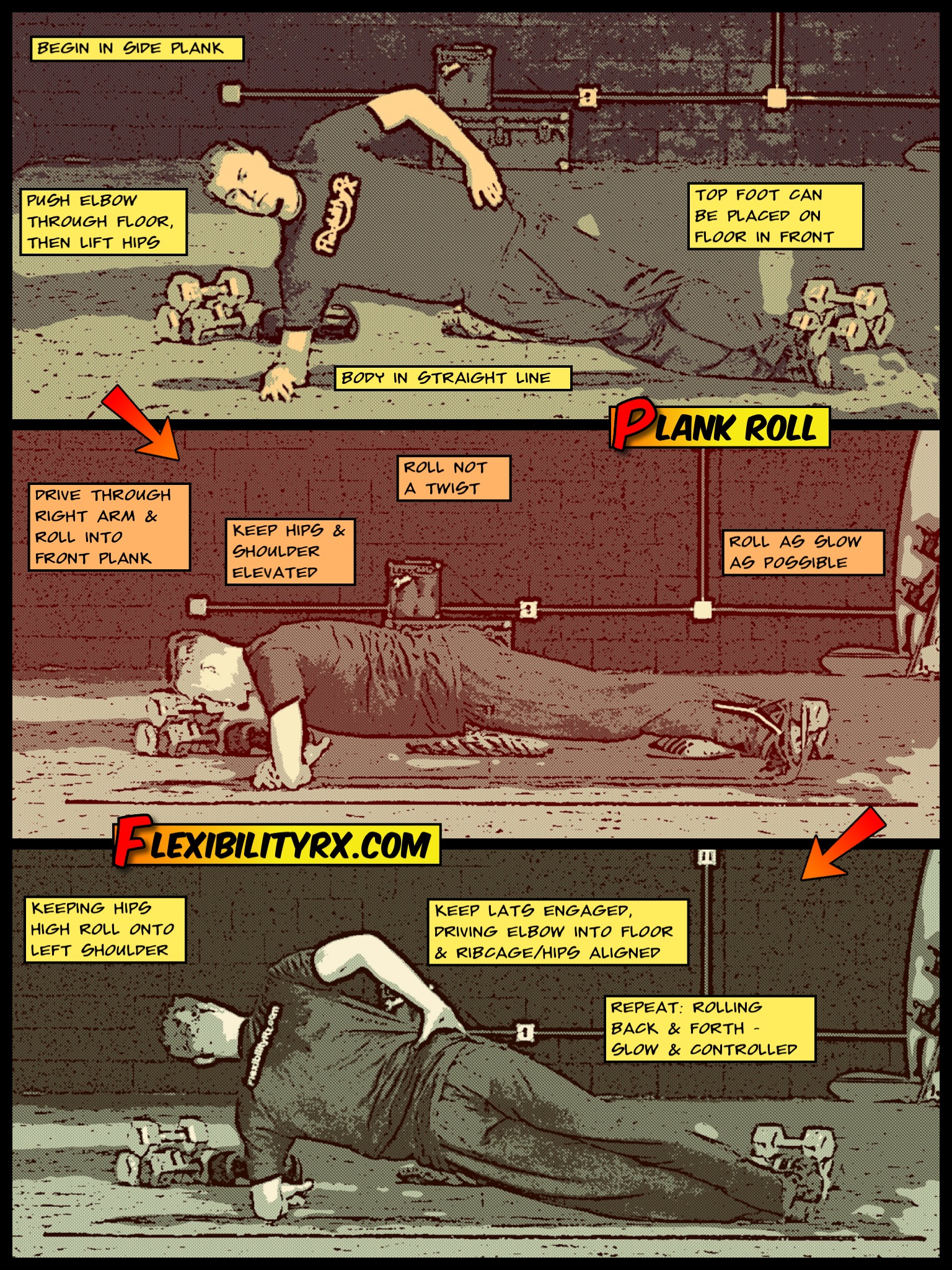
The Plank Roll Exercise
Planks are a fundamental core stability exercise that can easily be incorporated into a warm-up. Planks train stability in all three planes – the sagittal, frontal, and transverse planes – for anterior, lateral, and rotational stability.
The front plank is an anti-extension exercise that trains the low-back to resist lumbar extension. Imagine trying to finish a shoulder press and not being able to lockout the weight overhead without arching your low-back.
The side plank trains lateral stability – training the low-back to resist lateral flexion (side-bending). This is important for low-back/hip stability for single leg exercises.
The rotary band plank trains anti-rotation – training the abdominal obliques to resist lumbar rotation. The plank roll is a transition from a front plank to a side plank – training stability in all three planes. The transition from the front to side plank is an effective way to train rotary stability.
The Front Plank
The front plank trains the abdominals for lumbo-pelvic stability. Lumbo-pelvic stability refers to the ability of the lumbar spine and hips to maintain a good position. Signs of poor lumbo-pelvic stability include excessive anterior pelvic tilt, overextension of the low-back (during squats, deadlifts, and overhead presses), and rib cage flair (inability to fix the ribcage down).
The front plank aligns the spine while recruiting the abdominals and obliques to resist movement. Note the forearm crossed arm position – different from a standard plank or a RKC plank. This arm position supports the transition from a front to side plank.
The Transition
The transition from the front to side plank requires rotary stability – to resist rotation. The exercise is a roll not a twist – don’t allow the chest to collapse, shoulder round, or hips twist. Think of lengthening the spine throughout and lifting your body away from the floor by engaging your lats throughout the exercise.
The Side Plank
The side plank trains QL of the low-back (quadratus lumborum) and glute medius to resist lateral flexion. This lateral stability is important for single leg exercises like running, kettlebell carries, and pistol squats.
Planks are the Magic Bullet for Hip Mobility
Anterior core and lateral stability are important for maintaining hip flexibility. It may sound strange that an exercise like a plank can improve hip flexibility. Dean Somerset explains in this great blog that:
Limited hip internal rotation correlates to poor lateral stability
Limited hip external rotation correlates to poor anterior core stability
This means that a side-plank (lateral stability) can help improve hip internal rotation and that a front-plank (anterior core stability) can improve hip external rotation.
Athletes that do not stabilize their spine effectively – often end up tight hips. Quadratus lumborum of the low-back provides lateral stability to the spine and controls the hips. The abdominals in front provide anterior stability – fixing the ribcage down, stabilizing the hips, and resisting the downward contraction of the diaphragm.
The Joint-by-Joint Approach
The joint-by-joint approach popularized by Mike Boyle and Gray Cook explains that joints alternate between requirements for mobility and stability. When stability at one joint is lost (low-back) the joint above or below (hips) may lose mobility.
– Kevin Kula, “The Flexibility Coach” – Creator of FlexibilityRx™
Related Resources
Craig Liebenson, DC | The Misunderstood QL (link)
Chad Waterbury: Weakness in This Muscle Will Rob Your Power (link)
QL Training with Dr. Liebenson (link)
Dean Somerset: Planks are the Magic Bullet for Hip Mobility (link)
Gray Cook: Joint by Joint Approach (link)
FlexibilityRx™: Lateral Stability Sequence (link)
FlexibilityRx™: Rotary Stability Sequence (link)
Tags: abdominal execises, abdominal training, anterior core stability, front plank, joint by joint approach, plank roll, rkc plank, Rotary Stability Exercises, side plank

Leave A Reply (No comments so far)
You must be logged in to post a comment.
No comments yet